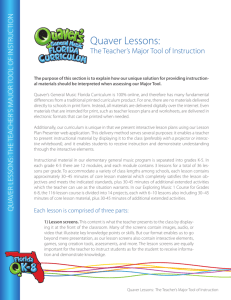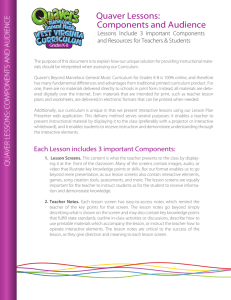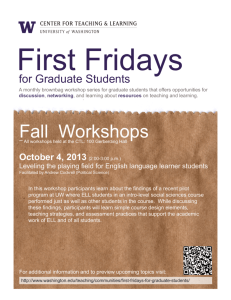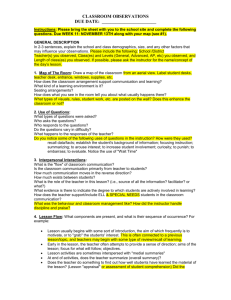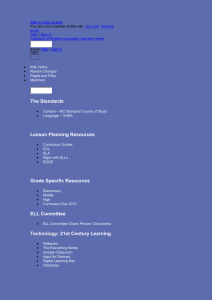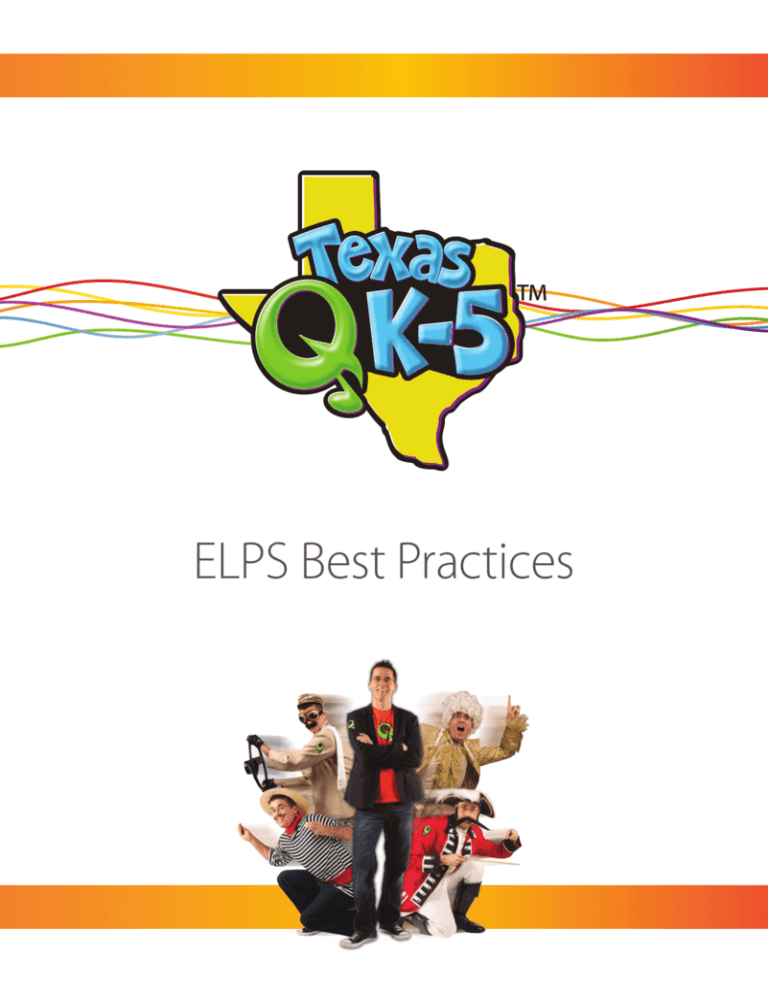
ELPS Best Practices
ELPS BEST PRACTICES
ELPS Best Practices
Introduction
This section includes general information and ideas to utilize or modify Quaver lessons for
meeting the goals of the ELPS (English Language Proficiency Standards).
The goal for teaching all English Language Learners (ELL’s) is to help them achieve comprehension, speaking, reading, and writing competence in the English language. The requirements to meet the needs of language acquisition are consistent with many good teaching
methods that most teachers already utilize daily.
The ELL classroom environment should be language-rich, always supporting the language
development of students using realia (real objects or pictures of real objects), manipulatives,
graphs, models, visual aids, and technology. Using QuaverMusic.com and the Texas QK-5
Curriculum readily addresses the classroom needs of ELL’s. Quaver’s Texas Curriculum avidly
supports ELL’s in gaining English language skills in a fun way that supports the overall goal
of comprehending, speaking, reading, and writing proficiently in English. In fact, Quaver’s
programs are already in use in many Texas districts that are overwhelmingly populated with
English Language Learners.
Best Practices for Teaching ELL’s
in the General Music Class
The 13 best practices for ELL’s discussed below are adapted from MusicEd.nafme.org (National Association for Music Education), citing articles in General Music Today, Winter 2007
& January 2011.
1. Create a Low-Risk Environment that is Safe and Nurturing
Quaver’s Seriously Fun approach to learning allows children to relax, laugh, and feel
safe in tackling new learning challenges. Students learn without even realizing it because they are having so much fun. This makes a potentially-intimidating music class
into a low-risk environment for the ELL where learning is safe and students feel nurtured and therefore more willing to take risks.
2. Be Patient
Listening is the first step in comprehension. Students often understand what is being
said to them in English before they can formulate a spoken response. It may take ELL’s
30
ELPS Best Practices
ELPS BEST PRACTICES
months or more to comfortably and confidently sing a song in English with the class.
Yet, each time the teacher exposes the student to English, that student is gaining
skills and confidence in the language.
3. Talk Less
Talking is a necessary skill for any educator! When working with ELL’s, however, it is
more beneficial to be concise and specific. Give short, clear directions with abundant
visual and body language cues. For example, when giving the direction to stand or
sit, show the students visually by standing up or sitting down while saying the words.
Visuals used in Quaver’s Texas Curriculum include very clear and concise text and are
filled with graphic cues and examples.
4. Allow More Wait Time
Teachers must consider the language processing of a non-native English speaker.
First, the student must hear what is said in English, translate that into their native language, formulate an answer in their native language, and finally translate that native
thought back into English. What a feat! Allowing additional time for ELL’s to formulate
a response will increase the probability that they will participate in the conversation.
Prior to class time, teachers can use Quaver’s customization tools to tailor the lesson
to a specific class’s needs. Even during class, teachers can easily adapt and navigate
among lesson elements, allowing them to present material at a slower pace or in a
different order for ELL’s while still meeting the lesson’s objectives.
5. Incorporate Visual Aids
Engaging all the senses in learning a language is key to success. A visual aid crosses
the language barrier and allows ELL’s to identify with the object or idea in their own
language before attempting to understand it in English. This is an important step on
the way to achieving the goal of language competence.
As a completely digital resource, Quaver’s Texas Curriculum is able to leverage the
most advanced technology to bring visual aids to life in every lesson, including: illustrated lyric pages, animated songs, rich illustrations, visual representations of key
terms, scores that highlight in time with the music, animated solfège and recorder
demonstrations, and much more. Students are sure to remember the vivid visual aids
in Quaver’s Texas Curriculum.
ELPS Best Practices
31
27
ELPS BEST PRACTICES
6. Use Gestures and Facial Expressions
Like visual aids, teachers can use gestures and facial expressions to communicate
with students of any language. The energetic character Quaver, who appears in
instructional videos throughout the Curriculum, makes ample use of gestures
and facial expressions to convey meaning. Students and teachers alike identify
with this approach and can’t help but respond to and emulate his enthusiasm.
Teachers using Quaver’s Texas Curriculum can easily build on this foundation,
and employ the same technique to reach their ELL students. The accompanying
teaching notes for each lesson also offer suggestions for using gestures and facial expressions.
7. Repeat Songs and Activities
Repetition is a key tool in helping ELL’s to internalize English language comprehension. Quaver’s memorable songs, activities, and other learning devices can
be revisited often to reinforce key concepts and vocabulary. Quaver has a knack
for making repetition fun, not tedious. Plus, not only do students get the opportunity to practice their skills in a safe class environment, but the language and
concepts being repeated will also likely be rehearsed internally throughout the
rest of the student’s daily activities.
8. Provide Opportunities to Demonstrate Understanding in Creative Ways
One way to measure ELL’s comprehension of English lyrics is through storyboarding or illustrating certain phrases. This will encourage practice, recall, and
proficiency, and demonstrate comprehension of the lyrics being learned. Each
song in Quaver’s ClassPlay library includes lyrics accompanied by descriptive illustrations to prompt students to remember the words. Other lesson activities
include fun listening maps, writing exercises, and opportunities for students to
write their own lyrics to familiar tunes. These activities help teachers strengthen
vocabulary and understanding in ELL’s.
9. 32
Incorporate Movement
Gestures, motions, and movements also help students focus on word meanings
and make them more willing to sing. Encourage students to create their own
movements to music. The songs in Quaver’s Texas Curriculum lend themselves
very naturally to movement, and some even include movement instructions in
the lyrics. Additionally, there are suggested movements incorporated in the lesson teacher notes where appropriate.
ELPS Best Practices
Use Cooperative Learning Strategies
Especially with older students, employing cooperative learning while strategically matching students (most proficient language abilities with less proficient)
will help with English language acquisition for students of varying levels. These
interactions improve the skills of each student, foster a trusting peer relationship,
and produce confident language role models. Cooperative learning creates leadership opportunities that bolster self-esteem. Quaver’s Texas Curriculum utilizes
cooperative strategies in multiple lessons throughout the program, from short
in-class activities to long-term group projects.
11.
ELPS BEST PRACTICES
10.
Reinforce Vocabulary Using Word Walls
One of the biggest obstacles to learning a new language is also one of the most
important aspects: learning the vocabulary. Vocabulary is they key that opens
the door of understanding, but it takes a lot of practice to retain. Word walls or
living walls are great tools to remind teachers and students alike to practice their
vocabulary terms. Each time a new word is learned add it to the wall, perhaps
with a picture or other definition to enhance retention and recall. Choose a creative way to group the words together – alphabetically, by topic, or sequence
learned – to enhance comprehension in different dimensions. Quaver’s Texas
Curriculum includes printable vocabulary terms with and without illustrations
and provide a perfect springboard for creating your own word walls.
12.
Recognize the Student’s Native Language and Celebrate their Culture
Using examples of the native culture of an ELL (as well as examples from other cultures) fosters a positive learning environment. Teachers can research folk
songs, singing games, nursery rhymes, and children’s literature from the specific
native language and culture of students in his/her class. Recognize and celebrate
nuances of the student’s native culture as often as possible.
Quaver’s Texas Curriculum includes many well-researched and well-represented
examples of world music and culture from across the globe. Students have the
opportunity to sing songs in other languages and to see translations of the lyrics.
13.
Rephrase Vocabulary Terms
Learning vocabulary is important to comprehension of any subject. Quaver’s Texas Curriculum goes beyond learning new terms by rote and includes fun illustrations, mnemonics, and associations to increase comprehension. Vocabulary
words are presented in a variety of ways throughout lessons, and students are
ELPS Best Practices
33
27
ELPS BEST PRACTICES
encouraged to use the new terminology in subsequent activities. Key terms and
concepts are explored throughout each Quaver lesson, not just reviewed at the
end. This improves learning retention and student comprehension of terms and
concepts.
14.
Explain Figurative Language, Including Jargon, Slang, Jokes, etc.
Colloquialisms, slang, jargon, figurative language, puns, play on words, and even
strong regional accents (“Howdy, y’all”) are understandably confusing to ELL’s. It
is important to help students understand that this type of language exists and
acknowledge that it can be confusing. It is also important to assure ELL’s that as
their English proficiency increases and improves, so will their understanding of
these confusing words and phrases.
ELL’s generally begin to understand this higher-level language skill as they approach High Advanced proficiency, but exposing them to the possibility of confusion between the literal meaning and the figurative wording might ease some
anxiety as they journey toward High Advanced proficiency.
Quaver’s Texas Curriculum strives to use clear and succinct terminology to explain all essential knowledge and skills. Yet, an important part of the Quaver mission is to use humor and fun to reach kids and help them to learn about music.
Some jokes and wording used in lessons (and perhaps even Quaver’s British accent) might require additional explanation for ELL’s. We hope that all students
will be able to laugh together and enjoy the fun of learning music with Quaver!
ELPS Summary
Although Fine Arts programs are not required to meet ELPS guidelines, Quaver’s Texas Curriculum supports English language acquisition in many ways that are embedded into the program.
Quaver resources provide a natural way to meet the language needs of English Language Learners. Lessons are easily customized and modifications can be made with little need for additional
teacher preparation or planning.
34
Quaver’s Texas Curriculum is made of engaging lessons that seamlessly teach music in a spiraling/scaffolding approach. Material is presented in a manner that also improves students’ overall
understanding and use of the English language. These improved English skills transfer back into
the classroom and yield better success for ELL students in core curriculum classes. So while ELL
students are learning music, they are also being fully supported in attaining English language
proficiency using Quaver’s Beyond Marvelous General Music Texas Curriculum for Grades K-5.
ELPS Best Practices
Copyright © MMXIV, by QuaverMusic.com, LLC. All trademarks designated “™” are the property of QuaverMusic.com, LLC. All stories, characters, artwork and other original material embodied in the product
including any printable materials are Copyright © MMXIII, by QuaverMusic.com, LLC All rights reserved.

